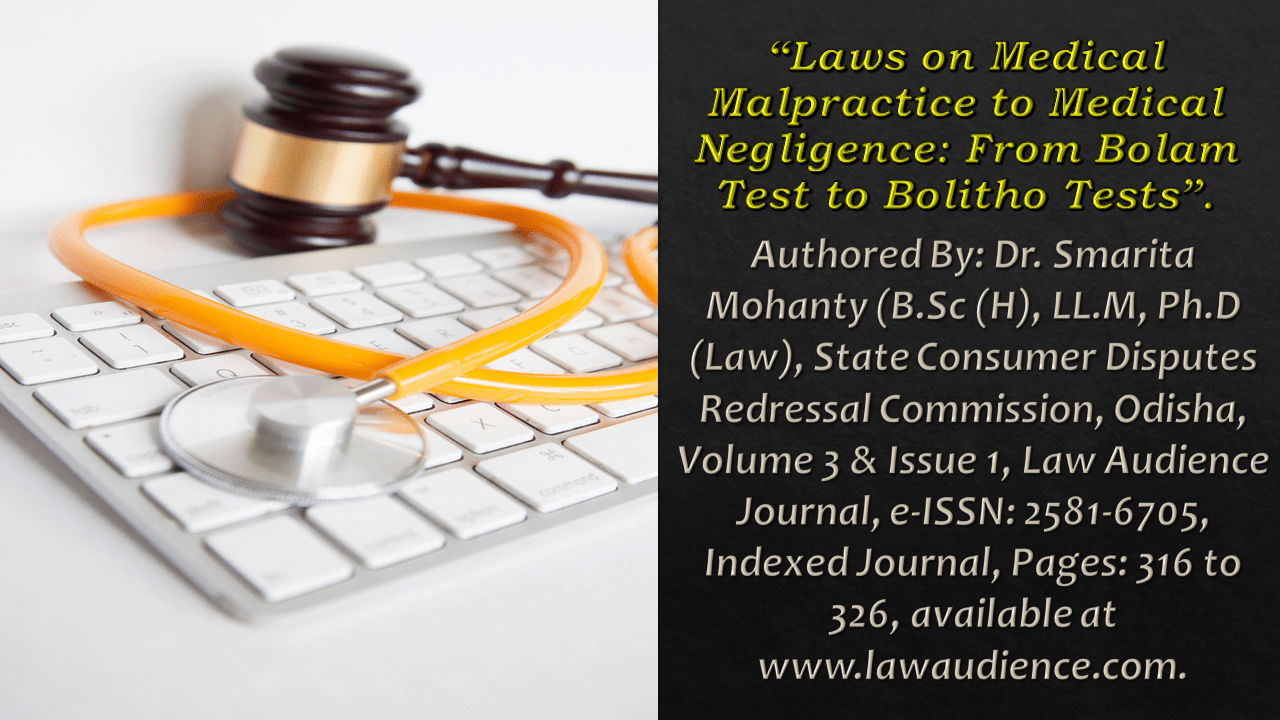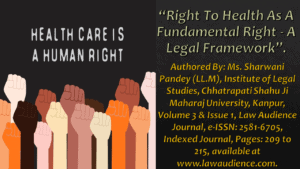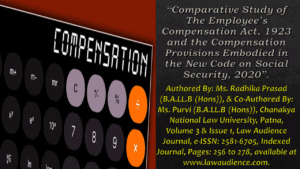Click here to download the full paper (PDF)
Authored By: Dr. Smarita Mohanty (B.Sc (H), LL.M, Ph.D (Law), State Consumer Disputes Redressal Commission, Odisha,
Click here for Copyright Policy.
ABSTRACT:
“Medical malpractice prevailed in ancient times. The ancient laws like the Hammurabi’s Code prescribed severe punishments for medical malpractice. The article presents the history of legislation dating back from 1754 BC to recent times. The paper depicts the Donoghue Case which was the turning point in the history of personal injury leading to the breach of contract. The case brought forth the difference between contractual relationship and negligence. This paved the path in the modern age to claim for the negligence of duty of care by a medical practitioner.
The author examines the principle of the Bolam Test prevalent in England. The principle has been followed by the Courts of India. It has become a standard while deciding cases with regard to medical negligence. The author has mentioned some of the cases where the Supreme Court of India has followed the Bolam Test. The Bolam Test centers around the duty of care by a medical practitioner.
In 1998 there was a shift from Bolam test to Bolitho Test which was based on logical reasoning given by expert opinion. It is tested how far the Bolitho Test applicable to India. Lastly, the Bolam Test applied by the Supreme Court of India reflects the balance between the judicial intervention and medical expertise”.
I. INTRODUCTION:
The ancient history reveals that there was legislation for medical malpractice. The medical practitioners were punished severely for the wrongs committed by them. The medical malpractice was considered as breach of contract which sifted to medical negligence which was a breach of duty conducted by a medical practitioner.
The origin of medical malpractice and its legislation dates back from the human civilization of Mesopotamia when the Hammurabi’s code was prevalent. There were established laws to convict the medical practitioner, but claims were very rare.
II. ANCIENT HISTORY OF MEDICAL MALPRACTICE LAWS:
It dates back to 1754 BC when Hammurabi’s Code was known to be the first document of human civilization in Mesopotamia, the origin of civilization. The code laid down nine laws relating to medical practice[1]. In 3rd Century Roman law set Lex Aquilia, which is one of the earliest compensation legislations for negligence. It defined that compensation could be provided to the owners of property injured by another person. The law preceded the foundation to medical negligence legislation in setting up a clarification from crime and stranded action in favour of compensation for a victim of negligent action[2].
In the 5th Century BC, the history of ancient Greeks shows that doctors used to swear for ethical behavior during their medical practice which is known as Hippocratic Oath. Writings on medical responsibility can be traced back to 2030 BC when the Code of Hammurabi provided that,
“If the doctor has treated a gentleman with a lancet of bronze and has caused the gentleman to die, or has opened an abscess of the eye for a gentleman with a bronze lancet, and has caused the loss of the gentleman’s eye, one shall cut off his hands[3].”
Under the Roman Law, medical malpractice was a recognized wrong. Around 1200 AD Roman Law was expanded and introduced to Continental Europe. After Norman Conquest of 1066 English Common Law was developed. At the end of the 12th Century during the reign of Richard Coeur de Lion ad, records provide medical malpractice decisions.
One early medical malpractice case of Everad vs. Hopkins[4], of England is an example where it was held that “both a servant and his master could sue for damages against a doctor who had treated the servant and made him more ill by employing ‘unwholesome medicine’.”
In the year 1374 recorded medical malpractice case. In case of Stratton vs. Swanlond[5], (the 14th century ancestor of the law of malpractice) a woman claimed the surgeon for not able to cure her mangled hand. Though, the judge dismissed her case for procedural error, but set ground of rules for future cases for medical practice.
In 1532, during the reign of Charles V, a law was passed that required the opinion of medical men to be taken formally in every case of violent death. The law placed a condition for expert opinion to establish the standard of care applied by the medical practitioner[6]. In 1794 United Stated reported first medical malpractice case. The plaintiff claimed a doctor as his wife died for improper operation conducted by the doctor. The plaintiff won the case and awarded 40 English Pounds as the doctor was negligent in conducting the operation leading to death of patient[7]. In 1847 American Medical Association was founded and is largest organization of physician. A resolution by Dr. Nathan S Davis led to the formation of uniform standards for medical education, training and practice as well as world’s first national code for ethical medical practice.
During the period from 1835 to 1865 United States witnessed increase in medical malpractice cases. Lawyers claimed that doctors did not use the proper skill, care or diligence while treating patients. In 1970s Courts in America published standards of medical malpractice awards. During this period almost every State passed reform laws for medical malpractice. Accordingly, California passed laws to control amounts to certain types of damages. In 1980s the increasing medical malpractice case led to passing of legislation. In 1984 witnessed a case where an 18-year-old girl was admitted to New York Hospital and treated by two residents. She died as her condition worsened due to negligent work of the doctors. Her father sued the doctor and won the case. Thereafter New York passed laws laying down the standards of work for nationwide reform[8].
In 2017 though the legislation helped increase safety for patients but doctors still make mistakes. On an average only 60% of claims are paid in malpractice cases. Surgery cases are the leading cases for claims from impatient incidents.
III. THE ESTABLISHMENT OF DUTY OF CARE:
Earlier in the 19th Century claims against medical practitioners were based on breach of contract rather the breach of duty of care towards a patient. Breach of contract was effective for trading purposes but not for the medical practitioner. In the case of Donoghue vs. Stevenson[9], Mrs. Donoghue contracted with gastroenteritis from a ginger beer that had a decomposed snail floating in the bottle. The case was brought before House of Lords. This case was a turning point in all personal injury case as the House of Lords established a clear difference between contractual relationships and negligence in essence; the manufacturer had a duty to ensure reasonable care and not to cause injury to their customer or anyone who were using their products. This established a precedent for personal injury cases going forward into the modern day.
The case of Bolam vs. Friern Hospital Committee[10], has set a precedent for the modern medical negligence or clinical negligence law. This case highlightened the fact that why the evidence of medical experts is highly important. The Judge Mc Nair, L.J. high-lightened that it was not for the judge to decide whether medical profession would decide a medical dispute and that medical profession would decide whether negligent treatment had occurred. Mc Nair, L.J. observed as follows: “I must explain what in law we mean by ‘negligence’. In the ordinary case which does not involve any special skill, negligence in law means this: some failure to do some act which a reasonable man in the circumstances would do, or the doing of some act which a reasonable man in the circumstances would do, or the doing of some act which a reasonable man in the circumstances would not do; and if that failure or the doing of that act results in injury, then there is a cause of action.”
Explaining further as to how to test whether the alleged act or failure is negligent and the answer given by the court is: “that in an ordinary case it is generally said, that you judge that by the action of the man in the street. He is the ordinary man in the street… But where you get a situation which involves the use of some special skill or competence, then the test as to whether there has been negligence or not is not the test of the man on the top of a Clapham omnibus, because he has not got this man exercising and professing to have that special skill….A man need not possess the highest expert skill at the risk of being found negligent. It is a well-established law that it is sufficient if he exercises the ordinary skill of an ordinary competent man exercising that particular art.”
The judgment in the Bolam case deemed that doctor’s standard of care must be higher as they have professional skills. At this point, juries were still being used for tort cases in England and Wales so it was up to the jury to decide if negligent treatment had occurred.
IV. AFTER EFFECT OF THE BOLAM TEST ON MODERN MEDICAL NEGLIGENCE CASE:
To prove medical negligence claim practitioner will depend on whether the treatment you receive was to a standard that could be reasonably expected. One must also prove that your injuries would not have occurred if it was not for negligence caused by a medical practitioner. In some cases, the injury was due to an illness being treated. The stage in which you will need to obtain a medical report from a medical expert stem directly from the Bolam vs. Friern Hospital Management Committee Case[11]. This advises whether treatment provided was without negligence. The Bolam Test still exists today and this is reflected in the need for medical witnesses to attest as to whether they think that negligent treatment has occurred using their professional knowledge and experience.
“Blame is the sole form of redress and the legal counter point between aggrieved doctors and patients in most developed countries. Like it or not, lawyers, doctors, and patients have all played leading roles in the history of medical negligence. Most countries have, eventually, arrived at a similarly confrontational and definitive legal process of dealing with medical negligence, usually some variant of tort in medical jurisprudence. Yet we know little of the social and historical process that has contributed to the development of medical malpractice and perhaps more importantly, what we define as medical negligence.[12]”
IV.I BOLAM TEST FOLLOWED IN INDIA:
The principle used in Bolam Case has been taken into consideration in India for a long time. The Bolam test was applied in the case of Suresh Gupta (Dr.) vs. Govt. of NCT of Delhi[13], This raised a question whether a new test to be adopted by India to fulfill the requirements of stringent medical negligence laws to check the increasing medical negligence.
In Jacob Mathew vs. State of Punjab[14], the Supreme Court of India examined what amounts to professional negligence.
The Supreme Court observed as follows:
“In the law of negligence, professionals such as lawyers, doctors, architects and others are included in the category of persons professing some special skill or skilled persons generally.
Any task which is required to be performed with a special skill would generally be admitted or under taken to be performed only if the person possesses the requisite skill for performing that task. Any reasonable man entering into a profession which requires a particular level of learning to be called a professional of that branch, impliedly assures the person dealing with him that the skill which he professes shall be exercised and exercised with reasonable degree of care and caution.”
The Supreme Court further observed while dealing with professional negligence held liable for negligence when;
- He lacks skill which he must possess and/or
- He fails to exercise his skill and reasonable competence which he possesses.
IV.II LIABILITY TEST:
Validating the Bolam test Indian Courts applied the same in all medical negligence litigation. The three requisites to be fulfilled for the test are as follows:
“i) It must be proved that there is a usual and normal practice,
ii) It must be proved that the defendant has not adopted that practice,
iii) It must be established that the course the doctor adopted in one which no professional man of ordinary skill would have taken it he had been acting with ordinary care.
The third requisite is the most important criteria of the test out of the other three”.
IV.III BOLAM TEST FOLLOWED IN INDIAN CASES:
In India, predominantly Bolam test has been accepted as a general rule. In Achutrao Haribhau Khodwa vs. State of Maharastra[15], Supreme Court held that, “the skill of medical practitioner differs from doctor to doctor. The nature of the profession is such that there may be more than one course of treatment which may be advisable for treating a patient.
Courts would indeed be slow in attributing negligence on the part of a doctor if he has performed his duties to the best of his ability and with due care and caution. Medical opinion may differ with regard to the course of action to be taken by a doctor treating a patient, but as long as a doctor acts in a manner which is acceptable to the medical profession and the Court finds that he has attended on the patient with due care skill and diligence and if the patient still does not survive or suffers a permanent ailment, it would be difficult to hold the doctor to be guilty of negligence….In cases where the doctors act carelessly and in a manner which is not expected of a medical practitioner, then in such a case an action in torts would be maintainable.”
In Poonam Verma vs. Ashwin Patel & Ors.[16], a doctor registered as medical practitioner and entitled to practice in the Homoeopathy only prescribed an allopathic medicine to patient. The patient died The doctor was held to be negligent and liable to compensate the wife of the deceased for the death of her husband on the ground that the doctor who was entitled to practice in homoeopathy only, was bound by statute not to enter into the practice of any other system of medicine which resulted in causing death of the patient. Such conduct of a doctor amounts to negligence per se actionable in civil law.
In Dr. Laxman Balkrishna Joshi vs. Dr. Trimbak Bapu Godbole[17], Court followed the Bolam Test was applied and approved. This test was also approved in State of Haryana & Ors. vs. Smt. Santra[18], in this case the surgeon was liable for compensation for failure of sterilization operation. Later in Dr. Suresh Gupta vs. Government of NCT of Delhi[19], the Court held that the applicability of Bolam Test in India for establishing medical negligence holds good.
IV.IV BOLAM TEST REVIEWED IN ENGLAND:
The Bolam case received criticism as variety of cases came before the Courts in England. Courts came up with alternative methods like concept of reasonability. Though the Bolam Test still holds good on the given factors, the changing scenario has been taken into account by the House of Lords. This has given way to broader liability regime.
V. THE BOLAM TEST SHIFT TO BOLITHO TEST IN ENGLAND:
The House of Lords decision in Bolitho vs. Hackney Health Authority[20], demonstrated a shift away from Bolam. It was no longer adequate for the standard of care professed by the defendant doctor to be approved by a responsible body of peers. In minority judgment comments in Bolitho case, it was stressed that- “the word ‘responsible’ in the traditional formulation of the Bolam test means that responsible practice is that which withstands the scrutiny at ‘logical analysis’ from a judicial perspective.”
In Bolitho case, Lord Browne Wilkinson recommended that experts should direct their minds to the question of comparative risks and benefits in order to reach a defensible conclusion on the matter in question. It was observed that a responsible conclusion must have arrived at by analyzing the clinical risk.
Bolitho has brought forth the consideration of logical analysis of risk. On appropriate consideration of clinical guidelines, it will similarly weigh the risks and benefits. With the consideration of doctrinal changes which lead to the evidence-based guidelines to play a greater part in medical litigation proceedings.
V.I THE BOLITHO TEST IN INDIA:
The Indian Supreme Court on two occasions mentioned the Bolitho Test. It was stated in Samira Kohli vs. Dr. Prabha Manchanda & Anr[21]., where the Court clearly pointed out that “A beginning has been made in Bolitho vs. City and Hackney Authority[22], and Pearce vs. United Bristol Healthcare NHS Trust[23]. We have however, consciously preferred the ‘real consent’ concept evolved in Bolam.” Similarly in case of Vinitha Ashok vs. Lakshmi Hospital[24], the court did not refer to the Bolam test. Court moving away from Bolan test clarified in Achutrao case [reported in (1996) 2 SCC 634], that- “A doctor will be liable for negligence in respect of diagnosis and treatment in spite of a professional body’s opinion approving his conduct where it has not been established to the courts satisfying that such opinion relied on is reasonable or responsible. If it can be demonstrated that the professional opinion is not capable of withstanding the logical analysis, the court would be entitled to hold that the body of opinion is not reasonable or responsible.”
V.II WHY BOLITHO TEST BE APPROVED IN INDIA?
It is unfortunate to say that medical negligence takes place every day in Indian hospitals and it is believed that there are almost one million such cases every year. Around one in ten patients suffer due to medical negligence in India. People claim for compensation for personal injury caused to them through a medical negligence.
The Bolitho test helps in getting quick relief as it increases the burden on the medical practitioner and the Indian Courts adopt the same model and implement it for larger interest of the public.
VI. CONCLUSION:
The Bolam Test enumerates that a medical practitioner is not liable if they have acted according to the responsible body of opinion. The Bolitho Test in comparison to Bolam Test has limited the scope of the test. It expressed that the body of opinion relied upon must satisfy Court on logical basis. That would be an improbable sea change in clinical negligence.
The evolution of the Bolam rule in the United Kingdom and the rule as administered in India by the Supreme Court contemplates a balance between judicial intervention and regard to medical expertise. As the Supreme Court has not set the judicial standard to test the opinion of medical expert, the Bolam rule in India has been variable and is likely to have an impact on the decisions made by medical practitioners. In due course, Bolam rule has become the basis of discussion encircling the conduct and level of skill the Court can expect from the medical practitioners. It is a vital point to note that from where these conduct and level of skills should be derived. This is a key point because neither judges nor doctors can work on their own to decide what standards must be used while deciding cases of medical negligence.
This rule has resulted in granting more power in the hands of the medical practitioner and deteriorated the adjudicatory powers of the Courts with respect to cases of medical negligence. The laws in India acknowledge the role of respectful submissions of judges dealing with the subject. The Indian Evidence Act, 1872 also permits to refer to expert opinion.
However, the Courts are not bound by such expert opinion. Experts provide with more information to a judge which helps in making a right decision. It is evident that expert evidence can never take away the authority of the Court as being the final arbiter in a case such as in Dayal Singh vs. State of Uttaranchal[25].
References & Footnotes:
[1] The History & Origin of Medical Malpractice, available at https://www.weisspaarz.com/history.
[2] History of Medical Negligence Claims, available at https://www.thompson and co-solicitors.co.uk/ history-of-medical-negligence-claims/.
[3] Powis Smith J.M., Origin & History of Hebrew Law, Chicago, IL: University of Chicago Press; 1931.
[4] 80 English Reports 1164 (1615).
[5] Pharos 1982 Fall; 45(4): 20-24.
[6] B. Sonny Bal (MD, MBA), An Introduction to Medical Malpractice in the United States, available at ncbi.nim.nih.gov.
[7] The First Medical Malpractice Case in the United States, available at https://www.bluegrassjustice.com/famous-medical-malpractice-cases/.
[8] Libby Zion Law, available at Libby Zion Law.
[9] [1932] UKHL 100.
[10] (1957) 2 All ELR 118.
[11] Ibid.
[12] Kim Price, Towards A History of Medical Negligence, (10) 60081-5, available at https://doi.org/10.1016/80140-6736.
[13] (2004) 6 SCC 422.
[14] AIR 2005 SC 3080.
[15] AIR 1962 SC 933.
[16] AIR 1996 SC 2111.
[17] AIR 1969 SC 128.
[18] J.T. 2000 (5) S.C. 34.
[19] supra note 13.
[20] [1998] AC 232.
[21] 1 (2008) CPJ 56 SC.
[22] supra note 20.
[23] (1998) EWCA Civ 887.
[24] 2001 SCC 731.
[25] (2012) 8 SCC 263.
Cite this article as:
Dr. Smarita Mohanty, Laws on Medical Malpractice to Medical Negligence: From Bolam Test to Bolitho Test, Vol.3 & Issue 1, Law Audience Journal, Pages 316 to 326 (7th July 2021), available at https://www.lawaudience.com/laws-on-medical-malpractice-to-medical-negligence-from-bolam-test-to-bolitho-test/.



